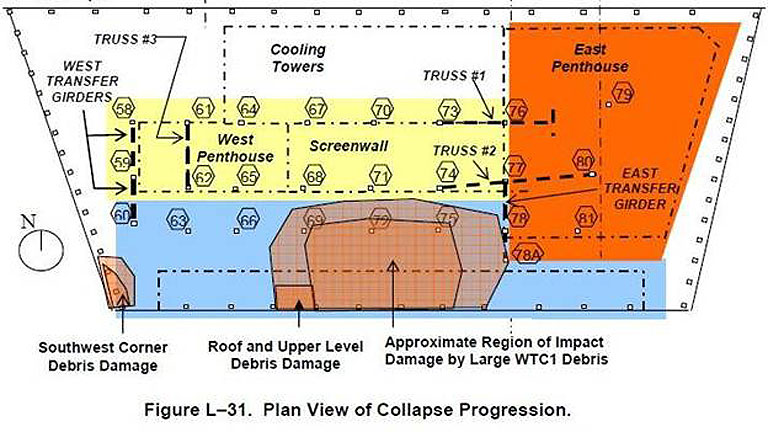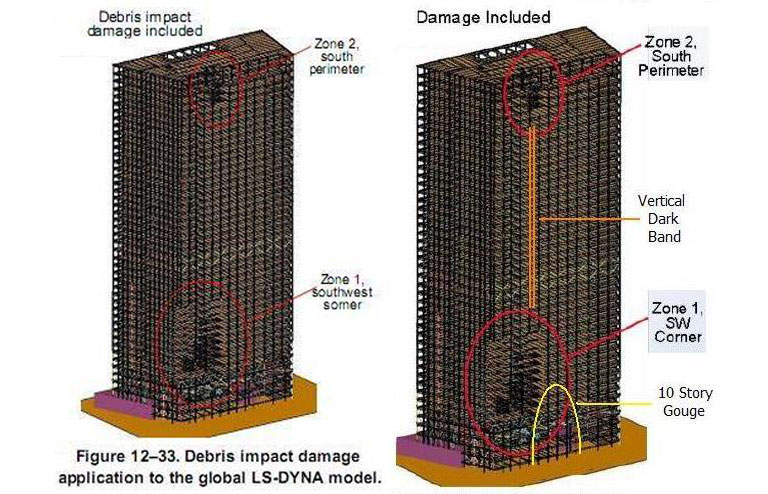Popular Mechanics' myth about the notorious gouge would remain debunked even if NIST had decided that the "dark band" represented a gouge.
Rebutting a Challenge to Our Six-Part Series on WTC 7
By Simon Falkner and Chris Sarns
As readers will recall, the second article in our six-part series on World Trade Center Building 7 debunked a myth that the National Institute of Standards and Technology (NIST) had propagated 10 years ago through Popular Mechanics' ironically-named article, "Debunking the 9/11 Myths."
According to this myth, a huge gouge, presumably caused by flying debris from the North Tower, had "scooped out" the bottom 10 stories of the center of the south face of WTC 7 (see our Figure 2).
Our article, published last December, proved that NIST never had any evidence for this gouge.
What's more, it revealed that NIST had acknowledged as much in its 2008 final report on WTC 7 by being strangely silent on the subject of the gouge — in marked contrast to the hoopla NIST had stirred up about this phantom gouge in the 2005 Popular Mechanics piece. Titled "PART 1: NIST and Popular Mechanics Fabricate Myth about WTC 7's 'Scooped-Out' 10 Stories," our article exposed the unprofessional and unethical practices on the part of NIST that had created this myth in the first place.
Since then, some of our readers have informed us that we have been accused, by a few so-called 9/11 Truth debunkers on a variety of Internet forums, of lying about the absence of the gouge. In short, it seems that the center-of-the-south-side gouge myth still lingers in cyberspace, despite the originator of the myth, NIST, having already given it up.
According to these online authors, AE911Truth is hiding certain photos (see our Figure 1) that prove the existence of that supposedly "scooped-out" section on the south face (see our Figure 2).
 Figure 1. Here are the two photos we are accused of hiding: Figure 5-80 (on the left) and Figure 5-81 (on the right) — both found in NIST's final (2008) report on WTC 7. According to NIST, the vertical "dark band" visible in these photos (see red arrows) extended from Floor 40 down to at least Floor 24 on the western side of the south face of WTC 7 (between columns 19 and 20). Overeager fans of Popular Mechanics (PM) claim that this "dark band" must be the huge gouge that was mentioned in its infamous 2005 article on the subject. It turns out that neither we nor NIST agree with the magazine's devotees.
Figure 1. Here are the two photos we are accused of hiding: Figure 5-80 (on the left) and Figure 5-81 (on the right) — both found in NIST's final (2008) report on WTC 7. According to NIST, the vertical "dark band" visible in these photos (see red arrows) extended from Floor 40 down to at least Floor 24 on the western side of the south face of WTC 7 (between columns 19 and 20). Overeager fans of Popular Mechanics (PM) claim that this "dark band" must be the huge gouge that was mentioned in its infamous 2005 article on the subject. It turns out that neither we nor NIST agree with the magazine's devotees.
Such an allegation is ridiculous for several reasons:
#1. These finger-pointers are in effect accusing our nemesis, NIST, of the exact same cover-up. Our December article showed a graphic of the gouge (see our Figure 2) that Popular Mechanics (PM) talked about in its infamous 2005 article and compared it to another graphic (see our Figure 3) from NIST's 2008 final report. This comparison made it obvious that the precisely identified gouge in the first report was missing in the final report. In other words, NIST was issuing a mea culpa without admitting it.
#2. The "dark band" NIST referred to is actually not proof of a gouge, let alone the gouge (see reason #3). Though NIST's final report did review that alleged photographic proof of the gouge (found in NIST's NCSTAR 1-9, Vol. 1, Chap. 5, pp. 169-171 [PDF pp. 213-215] and republished in our Figure 1), it did not conclude that the "dark band" proved damage to WTC 7's steel frame. Instead, it simply noted that some missing granite panels may have been the reason for the "dark band" in the photos — meaning that any damage done to the exterior could have been limited to a superficial blow from North Tower debris to the granite cladding. There is no evidence of damage to the steel frame.
 Figure 2. Figure L-31 in NIST's 2004 progress report showed the gouge that the PM magazine article talked about (labeled as "Approximate Region of Impact Damage by Large WTC1 Debris). It was supposedly a "scooped-out" section of the bottom 10 floors of the center of the south face of WTC 7. But our Figure 3 (below) shows that the "dark band" seen in our Figure 1 was in a completely different location from this alleged gouge.
Figure 2. Figure L-31 in NIST's 2004 progress report showed the gouge that the PM magazine article talked about (labeled as "Approximate Region of Impact Damage by Large WTC1 Debris). It was supposedly a "scooped-out" section of the bottom 10 floors of the center of the south face of WTC 7. But our Figure 3 (below) shows that the "dark band" seen in our Figure 1 was in a completely different location from this alleged gouge.
#3. Popular Mechanics' myth about the notorious gouge would have remained debunked even if NIST had decided that the "dark band" represented a gouge. That's because the "dark band" being referred to appeared on the upper left side (Floors 24 to 40) of the south face, whereas the mythical gouge was supposedly a "scooped-out" section of the bottom 10 floors of the center of the south face. Thus, a "dark band" gouge, if confirmed, would have been another gouge in a completely different location, while the claim of a "scooped-out" gouge would have stayed dead and buried — a thoroughly debunked myth (see our Figure 3). In other words, NIST's photos of the "dark band" were not relevant to the discussion in our December article and are still not relevant.
 Figure 3. The Figure 12-33 on the left, which is in NIST's 2008 final report, depicts its final estimate of the damage to the south face of WTC 7. When we compare it to the damage depicted in NIST's earlier (2004) progress report (see Figure 2), it's apparent that over that four-year span NIST had stopped believing in the existence of a huge gouge in the center of the bottom 10 floors. Nonetheless, NIST retained its theory of damage to the southwest corner — and even expanded that damage in Figure 12-33. In the image on the right, we depict the "dark band" (shown in our Figure 1 photos) and the mythical 10-story gouge (shown in our Figure 2) by superimposing on NIST's Figure 12-33 two vertical orange lines and a yellow arch. As you can see, they are nowhere near one another: The orange lines run from Floor 24 in NIST's Zone 1 to Floor 40 in NIST's Zone 2, and the top of the 10-story arch is another 10 stories from the bottom of the orange lines. Clearly, it is impossible to conflate one with the other.
Figure 3. The Figure 12-33 on the left, which is in NIST's 2008 final report, depicts its final estimate of the damage to the south face of WTC 7. When we compare it to the damage depicted in NIST's earlier (2004) progress report (see Figure 2), it's apparent that over that four-year span NIST had stopped believing in the existence of a huge gouge in the center of the bottom 10 floors. Nonetheless, NIST retained its theory of damage to the southwest corner — and even expanded that damage in Figure 12-33. In the image on the right, we depict the "dark band" (shown in our Figure 1 photos) and the mythical 10-story gouge (shown in our Figure 2) by superimposing on NIST's Figure 12-33 two vertical orange lines and a yellow arch. As you can see, they are nowhere near one another: The orange lines run from Floor 24 in NIST's Zone 1 to Floor 40 in NIST's Zone 2, and the top of the 10-story arch is another 10 stories from the bottom of the orange lines. Clearly, it is impossible to conflate one with the other.
In sum, we agree with NIST that the gouge celebrated by the 2005 PM article did not exist. If loyal readers of Popular Mechanics want to pinpoint just who is spreading disinformation, we suggest they listen to a claim made by the magazine's researcher/editor David Coburn in a 2006 radio interview, where he told Charles Goyette (starting at the 9:22-minute mark) that he had seen photos of the mythical gouge.
Did the City of New York Police Department show Coburn fake photos? Or are claims made by Popular Mechanics not trustworthy? You have eyes. You decide.






